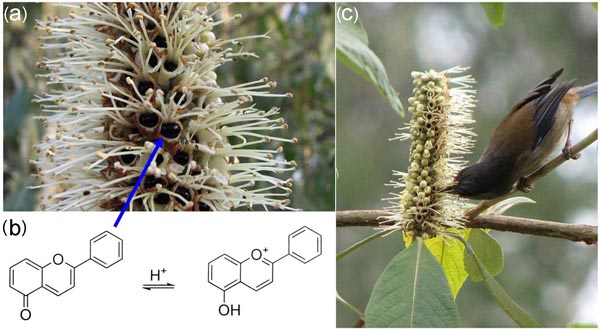Floral nectar is offered by plants to animals as reward for pollination, the co-evolution between visual signals produced by plants and the animal mutualsists is one of the most intriguing subjects in the evolutional biological sciences. In nature, while necar generally is a clear liquid containing sugar and trace amounts of amino acids, a few plant species produce intriguing coloured nectar. While this rare floral trait-coloured nectar has been recorded by Greek poet Homer since 1785, it has been somewhat under-researched by modern science. So far, 68 plant species with coloured nectar were known in the world, most of species occur in tropical and subtropical regions of the Southern Hemisphere.
Leucosceptrum canum stands out as unique plant with coloured nectar recorded in the Himalayas and adjacent southwestern China, but neither the chemical origin nor the functional significance of the nectar’s colour have been characterized.
Recently, Drs. ZHANG Fengping, CAI Xianghai, Profs. WANG Hong and LI Dezhu focused on the chemical compound associated with the dark purple nectar of L. canum, as well as its dynamics during the flowering season and its relationship to pollinators. The study found that this plant is self-compatible but dependent on pollinators to increase reproductive output, two short-billed birds (blue-winged minla and oriental white-eye) were found to pollinate this plant. A purple anthocyanidin, 5-hydroxyflavylium was identified, as a natural nectar product for the first time, and it was found to be the cause of the nectar colouration. Further, this plant employs two nectar-based mechanisms to direct bird pollinators to reproductively active flowers, controlling nectar palatability and presenting a foraging signal for birds by altering nectar volume and colour in a developmental stage-specific manner.
The mechanistic and functional analysis of dark nectar is of very high scientific interest, this innovative study makes a substantial advance to our understanding in the functional ecology of nectar coloration, and open other research avenues for studying the evolutionary significance of nectar coloration as a visual signal to effective pollinators.
The paper online published on “New Phytologist” (September 15, 2011), titled “Dark purple nectar as a foraging signal in a bird-pollinated Himalayan plant” (http://onlinelibrary.wiley.com/doi/10.1111/j.1469-8137.2011.03894.x/abstract).

Leucosceptrum canum flowers and pollinator. (a) The dark purple nectar (Arrow); (b) Structure of the anthocyanidin; (c) Blue-winged Minla feeding from flowers of L. canum. (image by KIB)




